By Capt. Wayne Canning, AMS
Whenever there is a major storm along the coast it is soon followed by a wave of damaged boats being sold by owners and insurance companies. These boats can often be a bargain for those with the skills and resources to repair them. They can also be the proverbial “hole in the water” waiting to be filled with money, sweat, and lost hopes. Before you start bidding on that great deal there are some important things to consider.
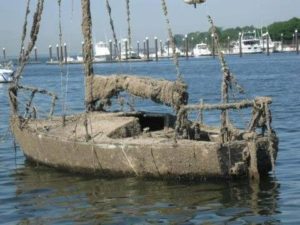
One of the first things to consider is the condition of the boat before the damage occurred. You might think the type of damage would be the first thing to consider but having an idea of the condition of the boat prior to the loss is the most important. Think of it as if you were buying a used boat without damage. You want to know if it has been well maintained or had any major defects. What are the engine hours? Are the sails in good condition? Ask the same questions you would if you were looking at a boat without damage. You are after all looking to buy a used boat. It will be enough work to fix the damage without having to completely restore the boat on top of that. This will also help you establish the pre loss value. Knowing this will help you come up with a realistic bid or offer.
Once you have determined the pre-loss condition and value the next step is to take a close look at the damage and what it will take to repair. This is something you want to overestimate not under estimate. Consider what work you can do yourself and what you will have to contract out as well as what parts and supplies will be needed. In most cases you will not have detailed information available to get a really good idea of all the damage so assume the worst. You also need to consider storage, transportation, insurance and other costs associated with the repair work. These all add up quickly.
According to OneSureInsurance.co.uk, it is critically important to understand the types of damage that can occur to a boat in a storm. There are several types of damage that occur and some damage is easier to fix than others.
Submersion. In general submersion causes the most damage and is one of the worst types of damage. The problem with submersion is that every part of the boat is affected. Any equipment and electronics that have been submerged are likely going to be ruined. Rarely an engine can be saved if attended to or “pickled” right away but this is rarely the case with storm damage. Boats often sit for days or even weeks before anyone can get to them and do any sort of preservation work. Often this is simply to late to prevent real damage. Submersion can also leave hidden damage that may not be discovered for months or years later. In general I recommend staying away from submerged boats but of course there are exceptions to all rules. Submersion in fresh water is better than salt and partial submersion is better than full. Submersion longer than a day or so will often damage any woodwork and soak deep enough into the wiring to require replacement. Because so much of what cannot be seen has been affected problems can continue long after the boat has been dried out. If you are thinking of a submerged boat be ready for a complete and total refit.
Dock Rash. This is one of the most common types of damage. As the name suggests it is caused by rubbing up against docks, pilings, and other boats. Although the damage can be straightforward to fix it can require the removal of interior components to gain access. It will also often require the replacement of rub rail and toe rails. This type of repair requires good fiber glassing skills as the repairer will be required to match the pre-lose shape and finish. Care has to be used to make sure there is no hidden damage as well. A vessel pounding against a dock or other hard object can “ehco” these forces to other parts of the boat. These transferred forces can result in hidden damage in the way of broken bonds on bulkheads, damaged hull/deck joints and other structural failures. Look the boat over carefully in areas opposite and away from the damaged areas. Water damage is also likely in the area of the dock damage where rain and sea water can enter. This can damage or destroy equipment and fixtures near the damaged area.
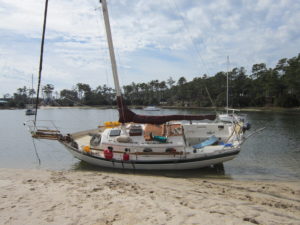
Groundings. This is common and is a result of the vessel coming loose from its moorings. Typically groundings will cause damage to the underwater fittings and gear. Check for bent rudders and propeller shafts as well as damaged propellers and keels. Check for fiberglass damage particularly at the turn of the bilge or on the chine. Even if it appears the damage is mainly on the outside of the vessel a careful inspection inside is required. Check the steering systems as forces on the rudders can easily damage parts inside the boat. Carefully inspect stringers, frames and bulkhead bonding as pounding on the bottom can cause inside structural failures not noticed from the outside. If the hull is cored be sure to look for “dents” or unfair spots in the boat hull wraps as these can indicate a fractured or compressed core.
Wind damage. Often first noted as shredded canvas and sails, wind damage can also include structural damage as well. I have inspected more than one sailboat dismaststed at the dock by a roller furling sail that came open during a storm. The mast falling on the deck or other boats can cause some serious damage to house tops and decks. Bimini tops and other canvas coming lose can also cause some surprising damage. I have seen flailing broken frames pound holes in fiberglass housetops. Wind driven rain can also cause serious water damage inside a boat as well. Wind damage can also include boats blown off their stands or supports creating damage much like of a really hard grounding.
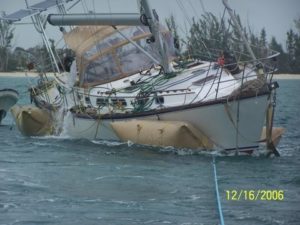
Salvage damage. This is damage done during the vessel recovery. The stresses and strains of pulling a boat off a beach or lifting and transporting it to a safe location can sometimes cause more damage than the storm. I know of one nearly new catamaran that had the bottom completely ripped out when the salvor pulled it across a reef during “recovery.” Very often after a storm salvage crews have many boats to recover and in their haste more damage can be done. When inspecting a storm damaged boat be sure to look for damage caused by the salvage operations. Cleats and bits ripped out, damaged rudders and running gear and rig damage are often the result of salvage operations.
Of course most damaged boats will have some if not all of the listed types of damage. This is truly a case of buyer beware, so make sure you have as much information as possible. Go see the boat in person if possible. Be sure to always get permission first though, as you do not want to be accused of being a looter. Hire a surveyor or other expert to attend the boat with you to offer their opinion. Often they know what to look for and can save you a lot of money by finding things you might not otherwise notice. If you cannot see the boat in person this is even more reason to hire someone to look the boat over.
Now that you have a better idea about what to look for in a damaged boat it is time to find that good deal. But where to start looking. Contacting insurance companies directly is often difficult and frustrating. They are often flooded with calls after a storm and simply do not have time to respond to every would be boat buyer. A better approach is to contact local surveyors, salvage companies, and local marine transportation companies. These people will often have the correct information on who to contact for auction or sales details. Also keep an eye out in local papers for auction listings. There are a few companies that specialize in selling off damaged boats and equipment as well. These companies can be found online and are worth checking. Depending on the size of the storm and number of claims, some insurance companies will rent land to store all the damaged boats. Visiting these lots may get you some more information as well.
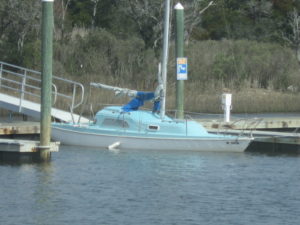
Before getting excited and placing your bid, read the fine print. Most auctioned boats require that the boat be moved, sometimes within days or hours of the auction close. This will not give you a lot of time to work out details such as where are you going to work on the boat or how are you going to get it there. Storage fees if the boat is not moved can sometimes be very high so do not assume you have time to get the details worked out later. There may be lots of boats auctioned on the same day so transporters will be busy. Some transport companies and marinas may require you to have insurance on the boat, but getting insurance on a salvage boat may not be easy. Also make sure you can get clear title to the vessel. These are all things to find out about in advance not after you have placed your bid.
Purchasing and restoring a storm damaged boat can be a rewarding way to get a boat at a reduced cost, but it can also end up being a big mistake. Understand what you are getting into before you have to write the check. Bids can often be a binding legal contract so having second thoughts may not be an option. I myself live on my hurricane salvaged boat so it can be done but there are many who wish they had not placed that bid. Take your time to get the facts; do not let emotions take over for commons sense. Set your top bid price and stick to it! No deal is so good you cannot walk away from it and it can be very hard to walk away from a bad deal.
If this was helpful please like and share below so that others will see it.

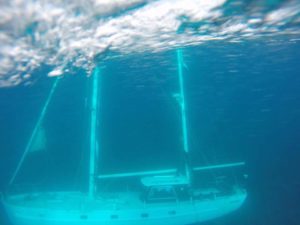
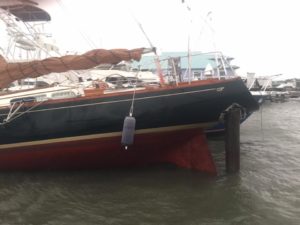

Thank you very much for your article. Following Irma, a friend of mine who has lots of boat experience is going to the BVI to find himself a catamaran. As I am currently looking for a bluewater boat myself to live on and cruise with my family of 6, he invited me to join in but I have doubts and worried the operation would end up more expensive than the saving. Following your article and others in the same direction, I don’t think I want to buy a storm damaged boat as a first home on the sea !